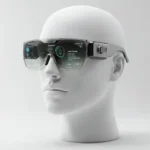Smart Glasses: Seeing the World Through an Augmented Lens
Smart glasses are no longer just a futuristic concept. Smart glasses use augmented reality (AR) out of our smartphones and seamlessly integrating digital information into our view of the physical world. But how exactly do these intelligent spectacles achieve this seemingly magical feat?
At its core, smart glasses use augmented reality by layering computer-generated content onto your real-world environment in real-time. Unlike virtual reality (VR), which creates entirely immersive digital worlds, AR enhances your existing surroundings with helpful or engaging digital overlays.
Here’s a breakdown of the key technologies that enable smart glasses use augmented reality experiences:
The Display: Merging Digital with Reality
One of the most critical components of AR smart glasses is the display system. Unlike traditional screens, these displays are designed to be transparent or semi-transparent, allowing you to see the real world clearly while simultaneously viewing digital images or information projected onto the lenses. Various display technologies are used, including:
- Waveguides: These thin, transparent materials guide light from a tiny projector at the edge of the lens directly into the wearer’s eye. This creates an image that appears to be floating in front of you.
- Micro-projectors: Small projectors can beam images onto the lenses or a separate transparent surface within the glasses frame.
- Retinal Projection: Some advanced systems aim to project images directly onto the wearer’s retina, offering high resolution and brightness.
These displays must be bright enough to be seen in various lighting conditions and offer a wide field of view to create a convincing augmented experience.
Sensors and Cameras: Understanding the Environment
To accurately place and anchor digital content in the real world, smart glasses are equipped with a suite of sensors and cameras that constantly gather information about your surroundings and your own movements. These include:
- Cameras: Front-facing cameras capture video and images of the environment. This visual data is crucial for recognizing objects, understanding surfaces, and tracking your position.
- Depth Sensors (like LiDAR): These sensors measure the distance to objects and surfaces, creating a 3D map of the environment. This allows digital objects to interact realistically with the physical space, appearing in front of or behind real-world items.
- Inertial Measurement Units (IMUs): Comprising accelerometers and gyroscopes, IMUs track the wearer’s head movements and orientation. This data is essential for keeping the augmented content stable and aligned with your view as you move.
- Microphones: Enable voice commands and interactions with the smart glasses.
Processing Power and Software: The Brains Behind the AR
All the data collected by the sensors and cameras is processed by a compact, powerful computing unit embedded within the smart glasses or connected wirelessly (e.g., to a smartphone). This processor runs sophisticated software that performs several key tasks for smart glasses with AR:
- Simultaneous Localization and Mapping (SLAM): This algorithm uses sensor data to build a real-time map of the environment while simultaneously tracking the glasses’ position within that map. This is fundamental for anchoring digital objects to specific locations in the real world.
- Object Recognition and Tracking: Software identifies and tracks real-world objects, allowing for contextual information to be overlaid. For example, pointing your glasses at a landmark could bring up historical information.
- Rendering: The software renders the digital content (images, videos, 3D models) and overlays it onto the camera feed of the real world, ensuring it is correctly positioned and oriented based on the SLAM and tracking data.
- User Interface: Manages how the user interacts with the AR content, often through voice commands, gesture recognition (detected by cameras), or small touch surfaces on the glasses.
Bringing it all Together: Smart Glasses with AR Experience
The magic of AR in smart glasses happens when all these components work in harmony. The cameras and sensors continuously feed data to the processor, which uses sophisticated algorithms to understand the environment and the wearer’s position. The software then generates and renders digital content, which is projected onto the transparent displays in a way that makes it appear as part of the real world.
For example, if you’re using AR navigation, the glasses use GPS and their internal sensors to determine your location and orientation. The software then overlays directional arrows and map information onto your view of the street ahead, guiding you without needing to look down at your phone.
Applications of Smart Glasses with AR
The potential applications of AR in smart glasses are vast and continue to grow:
- Navigation: Overlaying directions onto your path.
- Information Overlay: Displaying notifications, weather updates, or contextual information about objects you see.
- Remote Assistance: Guiding someone through a task by displaying instructions or annotations in their field of view.
- Training and Education: Providing interactive visual aids and simulations.
- Gaming and Entertainment: Creating immersive gaming experiences that blend the digital and physical worlds.
- Workplace Productivity: Providing hands-free access to data, manuals, and communication tools for various industries like manufacturing, healthcare, and logistics.
As the technology continues to evolve, smart glasses are becoming smaller, more powerful, and more seamlessly integrated into our daily lives, promising a future where augmented reality is a common and valuable tool for interacting with the world around us.
Additional helpful information
Smart glasses use AR for navigation – Smart Glasses With GPS and Navigation Services
Which is right for you? AR or VR smart glasses – AR vs VR Glasses: Differences, Uses & Future of Reality




